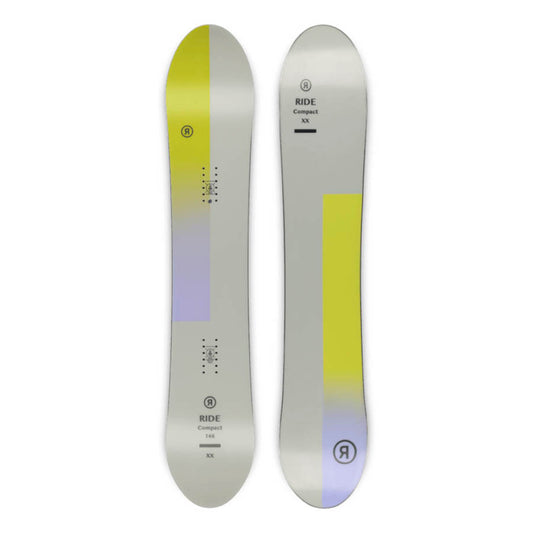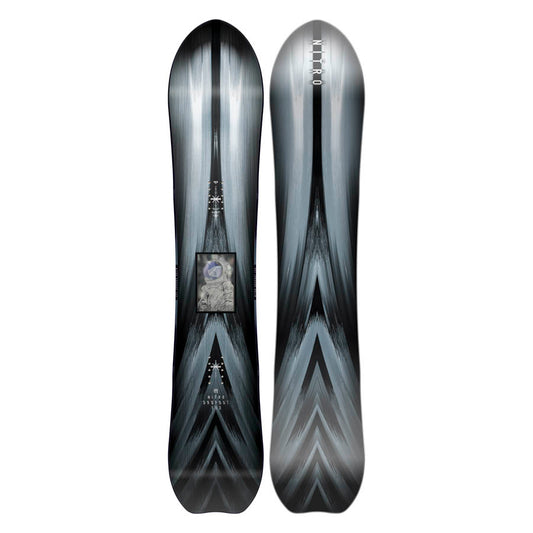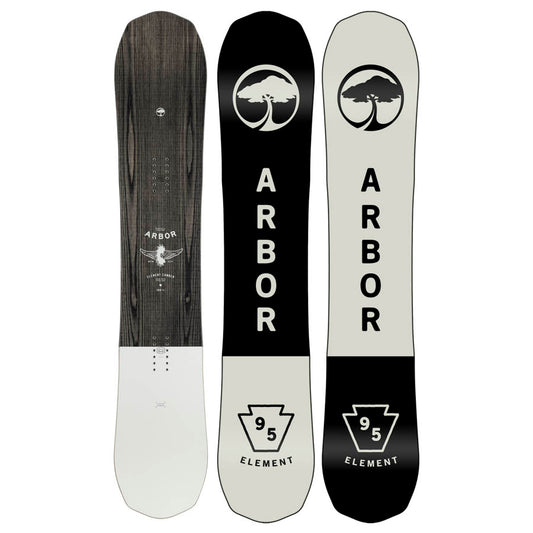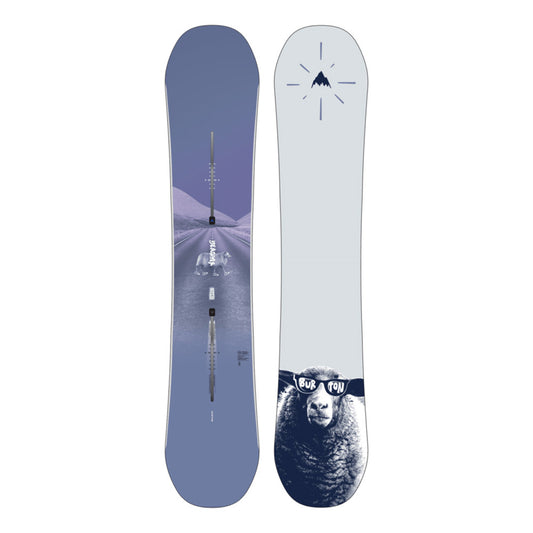There are many things to consider when buying a snowboard, but fortunately UtahSkis.com makes finding the right one easy. Often people make the mistake of buying a snowboard based on looks or simply from a brand they’ve heard of. This can get you into a board that may not be appropriate for you and could hinder your performance rather then help it. By using this guide along with the corresponding filters on our site you can be confident you’ve chosen the perfect board to fit your needs.

| Rider Height (in) | Rider Height (cm) | Rider Weight (lbs.) | Snowboard Size (cm) |
|---|---|---|---|
| 58 | 147 | 110 - 120 | 128 - 136 |
| 60 | 152 | 115 - 130 | 133-141 |
| 62 | 158 | 125 - 135 | 139 - 147 |
| 64 | 163 | 135 - 145 | 144 - 152 |
| 66 | 168 | 140 - 155 | 149 - 157 |
| 68 | 173 | 150 - 165 | 154 - 162 |
| 70 | 178 | 170 - 185 | 160+ |
| 72 | 188 | 180 - 195 | 160+ |
| 76 | 193 | 190 - 205 | 160+ |

Determining your skill level is probably one of the most critical steps in selecting a snowboard. It’s important not to over or underestimate your skillset. While it’s ok to get a board that you will be able to progress into, getting something that is too far out of your range of riding can make it harder while getting something too low can actually hold you back.
Beginner: A beginner rider is normally within their first season of riding. For many, this means trying to keep control of your speed and basically make it down the hill in one piece. You may be starting to connect turns but aren’t consistently. Riders at this level are usually just looking for a soft forgiving board with a simple design that will give them the confidence they need.
Intermediate: This is generally the rider that has had a few seasons under their belt. If you’re getting more and more comfortable linking turns and can generally make it down a blue run without catching an edge then you probably could consider yourself at least an intermediate level rider. Riders at this level are starting to look for a little more performance out of their gear and are experimenting with a little more speed or possibly some smaller terrain park features.
Advanced: Riders at this level usually have a feel for what type of terrain they prefer. They are comfortable with making quick turns and are in control at any speed. They may be specifically interested in riding in the terrain park or prefer carving hard on steep runs but either way they are confident in their abilities and generally have a preference as to what they’re looking for in their equipment. Boards at this level also are more specific to styles of riding as well.
Expert: An expert rider is extremely confident in their ability to take on any terrain under any conditions. No in bound run at a resort is too challenging and they may be exploring terrain out of bounds as well. A rider in this category is looking for the ultimate level for performance and technology out of their snowboard.




The next step is to determine what type of board you are looking for. It’s important to ask yourself where you’ll be doing most of your riding. For example, if you tend to ride groomed trails the majority of the time but occasionally go into the park it likely makes more sense to get an All Mountain Freestyle board rather than a true Freestyle board.

There are many different levels of all mountain snowboards, but overall they all provide riders with the ability to go anywhere on the mountain and do it all. Entry level riders through intermediate usually fall into this category as they Read more

Freestyle refers to the various types of riding often done in the terrain park including hitting rails, jumps, boxes and other tricks. Freestyle snowboards are generally soft and springy with lots of energy and pop for ollieing and doing tricks. Read more

If you truly like to explore the entire mountain, including the park or any natural jumps an All Mountain Freestyle board is truly the most versatile option. While it may not be a true twin, such as with its Freestyle Read more

Directional and a little stiffer than the average All Mountain board, boards in this category tend to be a mix of hard charging response with the versatility to float through powder. While these boards used to fit more of the Read more

Less of an everyday driver and more of a treat to bring on days where it dumps big, powder boards have one thing in mind; helping you float with ease. Often with big wide noses and tiny tails, powder boards Read more

Men’s snowboards are designed for men of all shapes and sizes. They are built to handle all types of terrain and skill sets.
Women’s snowboards are designed specifically for a woman’s body type. Women usually have smaller feet than men, so these boards are generally narrower allowing women to properly transfer energy to their edges. The flex is also generally softer so women can properly flex the board and as a result receive better control and response. Some brands use a lighter core on their women’s models as well.
The softer the board the more forgiving it is. This means the board does not respond as quick to your actions which is a positive when you are still learning.
Some riders prefer a soft flexing board for park or jib riding. This again allows for forgiveness when learning a trip or not quite landing something perfect. If you’re finding you’re feeling chatter at higher speeds, you may want something a bit stiffer.
Falling right in the middle, most intermediate boards will have a medium flex. This is perfect for a rider who is starting to pick up a bit more speed but is not looking for an aggressive board.
Riders looking for a stiff board are generally looking to ride fast and aggressively. They are concerned with not feeling chatter at higher speeds and want the board to feel responsive and powerful. Boards in this category are ideal for the advanced rider.
These boards are the ultimate in edge hold and response. While not as versatile as their counterparts, boards that fit this category are built to charge hard and transfer energy from the rider in the most efficient way possible. A rider looking for a board in this category should expect a demanding board with little forgiveness, but plenty of high-performance high-speed fun.
| Directional | Twin | Directional Twin |
| If a board is directional, it means the front (nose) of the board and the back (tail) of the board are not the same shape. The bindings are likely set back, and there’s generally more “nose” than “tail”. This means the board prefers to be ridden in one direction and can aid in floating in deeper snow as well as carving a turn at higher speeds. | Generally found in the freestyle category, a twin snowboard has a nose and tail that have the same dimensions and are built the same way. Basically, there is no front or back to the snowboard. This allows the rider to ride the board regular or switch (with your opposite foot forward) and have the board perform the exact same way. | Most boards are currently found under this category. This means the nose and the tail pretty much look the same but are slightly different and constructed different usually. This gives the board and the rider a little more versatility and is more appropriate for various types of riding. |
There are a variety of rocker profiles but most fall into the following categories.

Camber profiled snowboards are shaped like a rainbow when placed on the snow. The contact points near the tip and tail of the board touch the snow, while the middle of the board arches slightly upward. Camber gives riders pop, response, and performance. Rider’s looking for the ultimate in speed tend to prefer cambered boards.

Boards with full rocker are essentially the exact opposite as camber. When placed on the snow, the contact points near the tip and tail are raised out of the snow, while middle of the board touches the snow. This gives the board a more playful feel as well as more float in powder or deeper snow. Rockered boards tend to be more forgiving and are therefore a great option for beginners.

This is the most versatile options and really give you the best of both worlds. Where the camber and rocker are used may vary but the key is, the rider gets both the float, forgiveness and play of rocker with the added control and response of camber. Sometimes a completely flat section is utilized as well, which provides stability. This is a great option for someone who feels rocker boards are “too squirrely” and camber boards are “too demanding”.
Now that you’ve gone through all these steps it’s time for the fun part! You should always choose a board by what it does rather than by just the graphics but fortunately we’ve got lots of graphic choices as well. Most major companies make similar boards that fall into the same categories and price points so be sure to keep your mind open to different companies!



